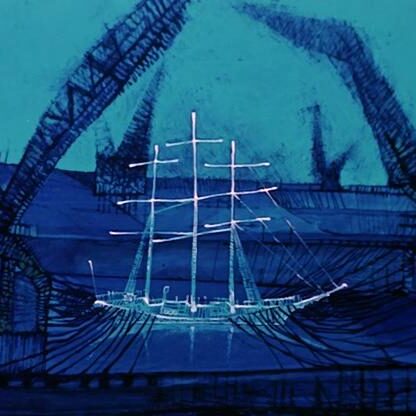Article written by Emmett Goodman.
International Animation Days occurs every year during the last week of October. The date is marked by the anniversary of the first public showing of Théâtre Optique, Charles-Émile Reynaud’s moving picture show, in 1892. Every year (or at the least the last few as far as I know), this day is celebrated with a special screening, one that celebrates the art and variety of animation.
This year, ASIFA-East’s celebration was organized by ASIFA-International correspondent Ray Kosarin. Ray managed to pull together a collection from one of the earliest exhibitions of the International Tournée of Animation. Founded in 1966, just some years before Spike and Mike, and many more years before The Animation Show, this was the only known showcase for animated short films from around the world. This particular collection is a handful of international shorts produced during the years 1968-1970. At this time, the show was produced by Prescott Wright, who would later be one of the founders of the Ottawa festival.
Sadly, there was a rather small turn-out for this screening. Someone suggested it was because most of our community had just attended Ottawa this past weekend, and possibly were too jet lagged, bus lagged, or had a lot of catch up to play. Whatever the reason, those of us who were unable to attend Ottawa got a nice treat with this screening.
Ray Kosarin introduced the show with a brief history of Prescott Wright and the Tournée. After mistaking “1995” for “1895,” and giving a shout-out to Dave Levy for his new book, the show went on.
We opened up with the opening titles and linking sequences from Tony Richardson’s The Charge of the Light Brigade (1968), animated by Richard Williams. I have to admit I had never seen these sequences, and found them enjoyable for the most part, if not a little tedious in other areas. But after that was a short by a Japanese animator named Yuri Koji. I have never heard of him, and I don’t think anyone else had, but his films (two were shown) were wonderfully charming, with cute soundtracks and an absurdist sort of humor. I am now curious to find more on Yuri Koji.
Included in this show are some early (I mean really early) examples of computer animation, made by John Whitney and sponsored by IBM. Mostly they are light shows creating various rudimentary shapes. The Tournée must have been the perfect place to screen these newfound experiments. Next up is Sirene, a quietly twisted film by Belgian filmmaker Raoul Servais. Then Rope Trick, a short by British animation great Bob Godfrey. It was later on that most of us determined a couple of traits found in English animation from this period, starting with Yellow Submarine. There is a lot of profiles and straight poses in the characters, which led to an almost “cut-out” look. This look carried on into Godfrey’s work and even into Terry Gilliam’s animation for Monty Python (okay, Gilliam’s American-born, but British enough).
The only American animation featured in this collection is another unknown group, the Haboush Company. One of the films shown is K-9000: A Space Odditym, directed by Robert Mitchell and Robert Swarthe. As the title suggests, this inky and scribbly film is a comedic parody of 2001: A Space Oddity (1968), with the astronaut being a music loving dog, first encounter Moon Cats, and then entering a mysterious void. There were more Haboush clips later on, some of which may or may not have been TV spots (the audience favorite being the tale of Economyland).
I have to admit, I failed to catch the name of some of these films. But most of the films (if not all) shared common traits. The hand-drawn films all had a certain look to them, characterized by thick, squiggly ink lines, almost as if the ink was bleeding. Dave Levy and Ray Kosarin both clarified that this look was probably due to the animators not having access to any xerography equiptment, which was the norm at the time, and probably were finding other ways to paint on cels. And also pointed out by Dave is that most of these films were more conceptual than story or character driven.
Remarkable films. And a truly remarkable collection. It seems appropriate to celebrate International Animation Day with a collection of classic films that demonstrate what animation artists are still hoping to achieve, and what can still be achieved.



